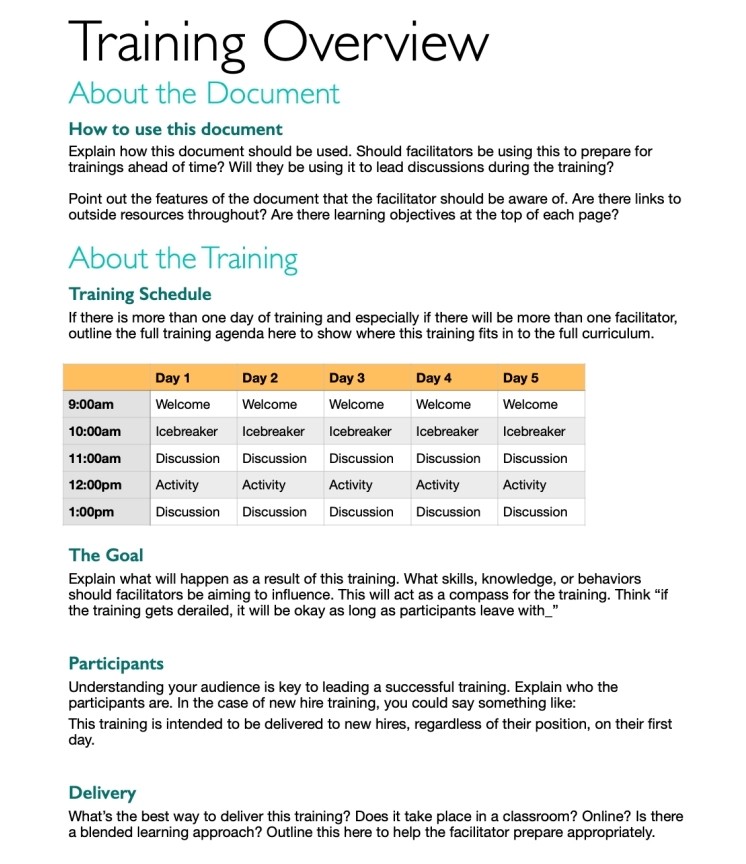Training is only as good as the facilitator leading it. While engaging content and a well-structured agenda are crucial, a skilled facilitator can elevate the learning experience, making it memorable and impactful. Even seasoned trainers benefit from a detailed facilitator guide. This article provides a comprehensive guide on How To Write A Facilitator Guide that empowers your trainers and ensures successful training sessions.
What Makes a Great Facilitator?
A good facilitator possesses more than just knowledge. They are comfortable speaking to groups, excellent communicators who can simplify complex topics, and active listeners who encourage participant engagement. While subject matter expertise is helpful, the ability to connect with and guide learners is paramount. A strong facilitator guide supports these qualities by equipping the trainer with the necessary information, discussion prompts, and activities.
Behind every successful training session is a well-crafted facilitator guide. This guide provides trainers with the roadmap, insights, and resources needed to deliver an engaging and effective learning experience.
What is a Facilitator Guide?
A facilitator guide is a comprehensive resource designed to help trainers understand the objectives of a training session and the best methods for delivering the material. Creating facilitator guides should be among the final steps in preparing Instructor-Led Training (ILT), ensuring that your guides accurately reflect the learning objectives and schedule. It’s a blueprint for success, ensuring all learning objectives are addressed effectively within the allotted time.
The Purpose of a Facilitator’s Guide
Think of a facilitator guide as a document you can confidently hand to a trainer on the day of the session, knowing they can use it effectively to conduct the training. It should be structured, detailed, and concise. The facilitator should use it both to prepare for the session and as a reference during the training. The guide should be descriptive and prescriptive, providing a framework while allowing the facilitator to incorporate their own expertise, ideas, and personality.
Key Steps: How to Write a Facilitator Guide
Creating an effective facilitator guide involves several essential components. Start with a template, or build your own, incorporating these must-have items:
Essential Components: What to Include in Your Facilitator’s Guide
Regardless of the training topic, effective facilitator guides share common elements:
- Training Session Goals: Clearly state the knowledge, skills, or behaviors learners should acquire by the end of the session.
- Table of Contents: Organize the guide for easy navigation.
- Learner Context: Provide an overview of what learners have already studied and how the training fits into the broader learning curriculum. This helps the trainer avoid redundancy and make informed assumptions about the learners’ existing knowledge.
To highlight key training sections, incorporate timing guidelines to help the trainer stay on track. A description for each section clarifies the purpose of discussions or activities. Provide sample talking points and discussion questions (with potential answers) as suggestions, especially for new trainers. Emphasize that these are suggestions, not scripts. The most engaging sessions are delivered by personable and animated trainers, not those reading verbatim.
Supplemental resources and learning materials (videos, articles) provide additional information for learners.
Here’s an example of how to define your training goals and define your objectives.
Alt text: A table outlining training overview, including learning objectives (Understand Workramp, Understand your team & role, Develop key skills), duration, and modules.
Preparing Your Facilitator for Success
Preparing the trainer is crucial. This includes preparation sessions and “train the trainer” classes to ensure facilitators are up-to-date on best practices. Involve the trainer in session preparation as early as possible, potentially even having them contribute to the facilitator guide. Who better to provide insights on what should be included?
When preparing a new facilitator, pair them with an experienced trainer for a practice session. Recruit someone outside the training process to provide feedback and adjust the guide accordingly. Encourage the facilitator to rehearse the session beforehand to address any questions about goals or strategies well in advance.
Leverage Your Facilitator’s Guide for Optimal Results
When selecting trainers, prioritize qualities beyond professional expertise. A great facilitator is empathetic, patient, adaptable, and accommodating. These leadership characteristics are often more important than deep subject knowledge, as the trainer can always defer technical questions to experts.
Beyond setting up trainers for individual ILTs, develop a reusable facilitator guide template. Design an editable template that is clean, simple, and readable. Use color variations, an agenda table, and clear headings for easy scanning. After each ILT, gather detailed feedback from the trainer to identify areas for improvement. Use this feedback to refine your template over time, creating better guides for future training sessions.
Crafting Your Own Facilitator Guide Template
Now that you know how to prepare your facilitators, let’s explore specific elements for your guide, beyond the overview mentioned above.
Facilitator Checklist
Provide a checklist of items the facilitator needs to prepare beforehand to facilitate effective planning.
Agenda
A clear agenda helps participants understand the training structure. Include specific times for events to help participants coordinate schedules and manage expectations.
Alt text: An example of a facilitator guide agenda, including time, module, activity, and materials needed.
Training Objectives
Clearly state the skills participants will learn and what they will be able to do after completing the training. By focusing on how to write a facilitator guide with clear objectives, you ensure everyone is aligned on the desired outcomes.

